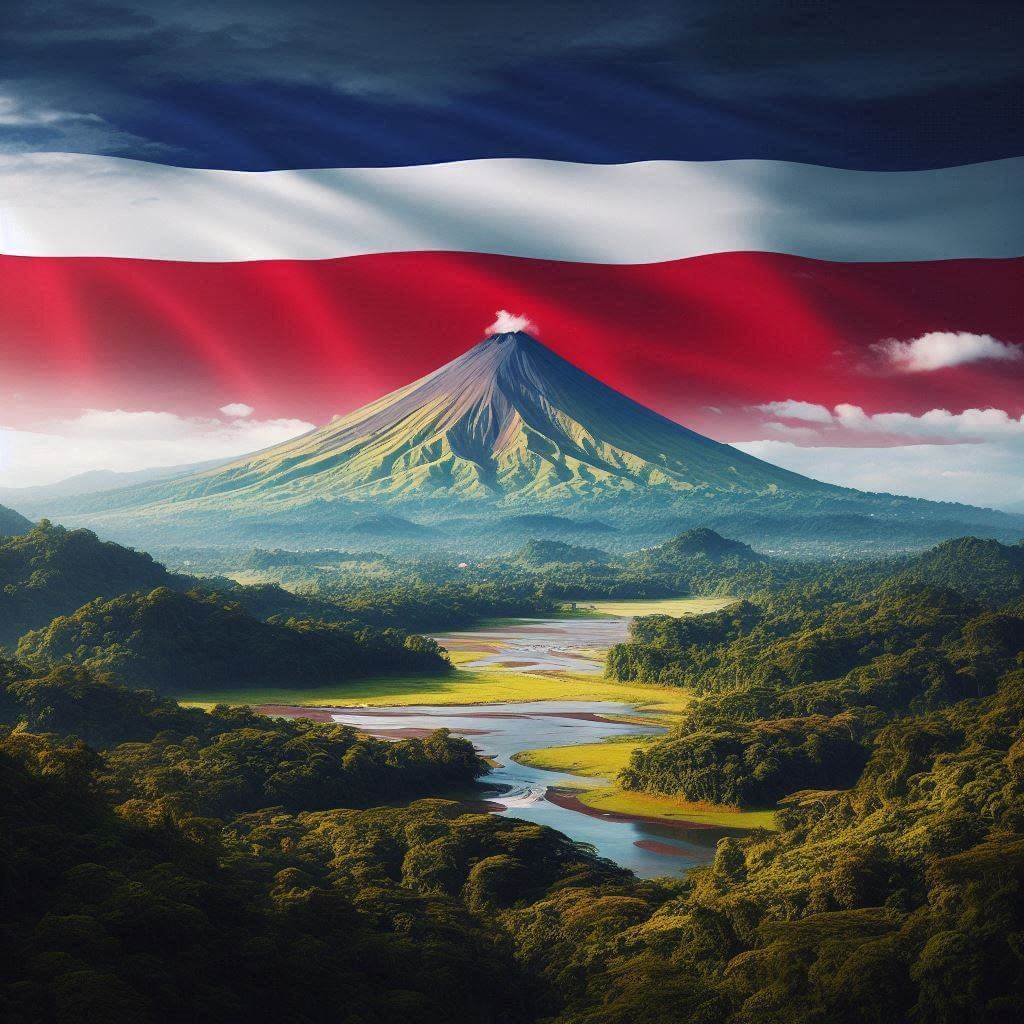La bandera de Costa Rica consiste en cinco franjas horizontales de azul, blanco, rojo, blanco y azul, con el escudo nacional en un disco elíptico blanco sobre la franja roja. Este diseño único incorpora elementos tanto de orgullo nacional como de influencia internacional, lo que lo convierte en un fascinante tema de vexilología.
Información sobre Costa Rica
| Día Nacional de la Bandera | — |
| Estado soberano | Sí |
| Nombre oficial | República de Costa Rica |
| Capital | San José |
| Población | 5,109,429 |
| Área | 51,100 km² |
| Moneda | Colón costarricense (CRC) |
| Idioma | Español |
| Continente | América del Norte |
| Región | América Central |
| Subregión | — |
| Fronteras | Nicaragua, Panamá |
| Zona horaria | Hora Estándar Central (CST) UTC-6 |
| Código de llamada | +506 |
| Dominio de nivel superior | .cr |
Historia de la Bandera de Costa Rica
 La bandera actual de Costa Rica fue adoptada oficialmente el 27 de noviembre de 1906, aunque sus orígenes se remontan a 1848. El diseño fue creado por Pacífica Fernández Oreamuno, esposa del entonces presidente José María Castro Madriz. Se inspiró en el Tricolor francés, reflejando la admiración de Costa Rica por los ideales de la Revolución Francesa: libertad, igualdad y fraternidad.
La bandera actual de Costa Rica fue adoptada oficialmente el 27 de noviembre de 1906, aunque sus orígenes se remontan a 1848. El diseño fue creado por Pacífica Fernández Oreamuno, esposa del entonces presidente José María Castro Madriz. Se inspiró en el Tricolor francés, reflejando la admiración de Costa Rica por los ideales de la Revolución Francesa: libertad, igualdad y fraternidad.
Simbolismo y Diseño de la Bandera de Costa Rica
El diseño de la bandera está lleno de simbolismo, con cada color y elemento que lleva un significado significativo:
- El azul representa el cielo, el idealismo y las oportunidades disponibles para todos los costarricenses.
- El blanco simboliza la paz, la sabiduría y la felicidad, reflejando el compromiso de la nación con los valores democráticos.
- El rojo representa la calidez del pueblo costarricense, su amor por la vida y la sangre derramada por la libertad.
- El escudo de armas, añadido en 1848 y modificado en 1906, representa el paisaje de Costa Rica, incluidos volcanes, valles y tanto el Océano Pacífico como el Mar Caribe.
Evolución de la Bandera de Costa Rica
La bandera ha sufrido varios cambios desde que Costa Rica obtuvo la independencia en 1821:
- 1821-1823: Costa Rica utilizó la bandera de la República Federal de Centroamérica.
- 1823-1824: Se utilizó una bandera blanca con una estrella roja en el centro.
- 1824-1848: Se utilizaron varios diseños, incluida una bandera con franjas horizontales azules y blancas.
- 1848-1906: Se introdujo el diseño actual, pero con un escudo de armas diferente.
- 1906-presente: Se adoptó oficialmente el diseño actual con el escudo de armas moderno.
Uso y Significado de la Bandera de Costa Rica
 La bandera es una fuente de orgullo nacional y se exhibe prominentemente durante celebraciones patrióticas, como el Día de la Independencia el 15 de septiembre. Ondean en edificios gubernamentales, escuelas y espacios públicos. Los costarricenses a menudo usan los colores de la bandera en ropa y decoraciones durante los días festivos nacionales, mostrando su patriotismo y unidad.
La bandera es una fuente de orgullo nacional y se exhibe prominentemente durante celebraciones patrióticas, como el Día de la Independencia el 15 de septiembre. Ondean en edificios gubernamentales, escuelas y espacios públicos. Los costarricenses a menudo usan los colores de la bandera en ropa y decoraciones durante los días festivos nacionales, mostrando su patriotismo y unidad.
Datos Interesantes sobre la Bandera de Costa Rica
- La bandera de Costa Rica a menudo se confunde con la bandera de Tailandia, que tiene los mismos colores pero en una disposición diferente.
- El diseño de la bandera refleja el apodo de Costa Rica, "Suiza de Centroamérica", debido a su neutralidad y naturaleza pacífica.
- El escudo de armas en la bandera presenta siete estrellas, que representan las siete provincias de Costa Rica.
- Costa Rica es uno de los pocos países del mundo que se ha desmilitarizado, lo que se refleja en el énfasis de la bandera en la paz y la democracia.





